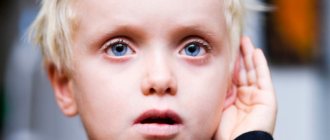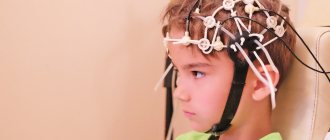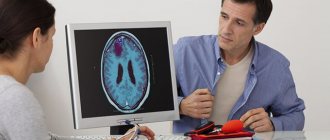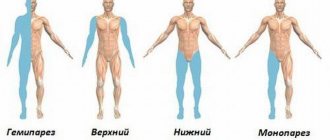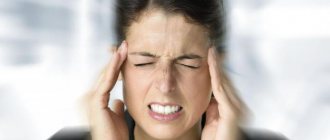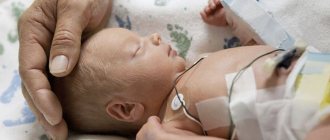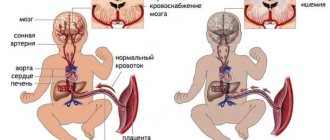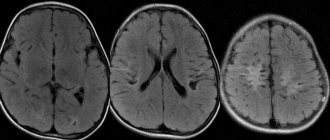Absence epilepsy is a form of neurological disorder characterized by nonconvulsive seizures with loss of consciousness for a third of a minute.
Absence epilepsy manifests itself with symptoms that are not obvious at first glance. Children begin to “freeze”; such freezing is nothing more than a non-convulsive seizure. A child suffering from absence epilepsy falls into a short-term stupor, as if he switches off and looks at one point. Seizures occur mainly during the daytime.
Such freezes in medical language are called absences. The onset of the disease occurs between the ages of three and eight years, with girls affected more often than boys. An EEG study in a person reveals an epileptic focus that creates impulses that excite parts of the brain and disrupt its activity.
Why a small patient may develop absence epilepsy, let's look at the main reasons. Causes of absence epilepsy:
– Presence of a tumor in the brain; – Destruction of brain matter during childbirth; – Head injuries; – Hereditary burden; – Inflammatory diseases of the meninges; – Hyperventilation of the lungs; – Excessive intake of toxic foods into the baby’s body;
The difficulty is that parents “attribute” non-convulsive seizures to the fact that the child is tired, to an unwillingness to concentrate on one thing, or inattention. Therefore, absence seizures are taken “as normal” and the disease slowly begins to develop and progress. Consequently, no treatment is provided, and the child continues to periodically pass out. In the absence of proper treatment, absence epilepsy is resisted (strengthened, established).
Diagnosis and treatment
Absence epilepsy in children is diagnosed by a neurologist. The specialist will prescribe an electroencephalogram and interview adults about the frequency, duration and symptoms of seizures in order to get a complete picture of the disease and exclude possible concomitant forms of epilepsy. MRI in the case of absence epilepsy does not give much results, since the picture in the image appears without any significant changes in brain activity.
If epilepsy occurs due to the presence of cysts, injuries, or infections, then efforts are first made to treat these provoking factors. Antibiotics and anti-inflammatory drugs may be prescribed, and sometimes surgery is necessary to remove the tumor. Then the treatment of seizures is carried out with antiepileptic drugs, which are prescribed individually, in accordance with the age, health status and course of the patient’s illness.
Periodic monitoring of the child's condition will help control his seizures. In general, epilepsy in children responds well to therapy; drug treatment can last for several years, but it is followed by a period of long remission or complete relief from the disease. There are also situations when the attacks go away on their own in the period from 10-14 years, but this does not always mean that the disease has disappeared with the attacks. Advanced epilepsy with absence seizures can progress to other, more severe types of epilepsy with convulsions and seizures.
Causes
Among the causes of absence seizures, experts primarily name epilepsy. This includes various diseases and conditions that cause brain damage. Most often these are encephalitis, meningitis, brain tumors, as well as injuries that were received in this area during childbirth or during childhood. Doctors constantly remind that with absence seizures
You should consult a specialist as soon as possible, because in this case there is the greatest chance of maintaining good health, while reducing the risk of complications. This disease is treated by a neurologist, so consultation with him is mandatory.
Treatment
In this section we will tell you what drugs are used for absence seizures and which doctor treats seizures. We’ll also talk about how to protect your child from new paroxysms.
Who should I contact?
A doctor who treats epilepsy and absence seizures is called an epileptologist. This is a specialized specialist who knows how to diagnose and treat this form of the disease. For such specialization, a neurologist must undergo advanced training courses or a special training cycle. In addition, he must have extensive experience in the management and treatment of such patients. Unfortunately, there are few neurologists-epileptologists and it is not always possible to get an initial appointment with them.
Fortunately, a neurologist can also provide first aid to a child and an adult. A set of examinations is prescribed by a pediatrician. It is important to contact any specialist in a timely manner, and not wait months for a specialist consultation.
Medicines and psychotherapy
Anticonvulsants are used in the treatment of epilepsy. And here an individual approach to each patient is important. After all, the choice of remedies is quite wide, but the number of side effects from therapy depends on the body. If the therapy is poorly tolerated, a patient is more likely to refuse to take medications, which will worsen the situation with treatment and control of the disease.
Typical absence seizures are treated with ethosuximide or valproic acid. Monotherapy is used. In case of resistance, Lamotrigine is used.
Side effects of various anticonvulsants:
| Ethosuximide | Ataxia and dyskinesia, decreased concentration, increased seizures, hallucinations, parkinsonism, nausea, dyspepsia, aplastic anemia, agranulocytosis. |
| Valproic acid | Liver damage, nausea and vomiting, drowsiness, tremor, loss of sensitivity, hair loss, pancreatitis. |
| Lamotrigine | Drowsiness, aggression, anxiety, double vision, imbalance, problems with hematopoiesis, liver failure, skin rashes, hypersensitivity reaction. |
In case of resistance, combinations of drugs can be used. In severe cases, doctors add medications such as Levetiracetam, Phenytoin, Tiagabine, Carbamazepine, Phenobarbital.
If mental disorders develop, a psychologist, psychotherapist or psychiatrist is involved in treatment. Typically, for such patients, personal counseling and psychotherapy are sufficient; they do not require medications. It is important that the condition of children with absence seizures is monitored not only by parents and doctors.
Educators and teachers should pay special attention to them. At the first signs of impairment (loss of concentration, poor performance at school), they require additional classes. Creative methods of psychotherapy are suitable for such children: music, drawing, doing crafts.
Surgical treatment
Absence epilepsy is a benign disease with a mild course. It is well controlled with medications and can go away on its own over time (upon reaching maturity). Therefore, the risk of surgical treatment of the disease, especially in childhood, is not justified. It is recommended to monitor the child regularly. And parents need to follow rules that will not allow the disease to become complicated.
In adults, the absence form of the disease may result from the presence of a space-occupying lesion in the brain. In this case, surgical treatment is mandatory. After all, it will not only help relieve a person from attacks, but also prevent the development of other dangerous complications. The decision on the method and extent of the operation is made by the neurosurgeon on an individual basis. The choice of treatment method depends on the quality of the formation and its location. For consultation, it is necessary to have CT or MRI data for recent years.
Restrictions for epilepsy
It is important for a child with absence seizures to follow a healthy lifestyle:
- Lack of sleep should not be tolerated;
- Excessive physical or intellectual fatigue is dangerous (however, normal load, on the contrary, allows you to reduce the frequency of paroxysms);
- You should limit your computer, TV, tablet and other gadgets. Screen flickering provokes generalized seizures of epilepsy, but can also cause absence seizures;
- The child should be protected from stress;
- Diet is recommended. Coffee, tea, soda, chocolate are prohibited;
- Professional sports are contraindicated;
- It is contraindicated for boys and girls to visit clubs and discos;
- Adults are not allowed to drive or operate machinery.
Interesting! How to distract a child from absence seizure? A true attack occurs with a loss of consciousness, so no one can bring the patient out of this state. It is important to wait until the end of the seizure and check the patient’s condition after it. Sometimes children and adults with absence seizures lose muscle tone and fall, receiving various injuries.
Prognosis and prevention
In children, the disease has a benign course and tends to go away at the end of the period of maturity. Boys and girls, as a rule, remain under medical supervision for life. And in adults, the prognosis is influenced by the underlying disease that provoked the pathology. The criteria for the benign course of absence epilepsy are indicated above.
So far, scientists do not have the ability to program the birth of healthy children. In the case of idiopathic absence seizures, the disease lies in the genes. And, unfortunately, they cannot be corrected yet.
As for secondary attacks, you should be attentive to your body: avoid injuries, consult a doctor in a timely manner, and undergo an annual medical examination. This will allow timely detection of an infection or brain tumor. Sick people are advised to lead a healthy lifestyle and follow the points mentioned above. This will make it possible to avoid new attacks.
Absence epilepsy is not a death sentence, but only a reason to be attentive to your health or the well-being of your child. Don't despair! Listen to the doctors' recommendations and take medications, and then the disease will subside.
Classification of attacks and pathogenesis of development
As mentioned above, there are idiopathic and secondary absence seizures. The first option occurs against the background of the absence of organic brain pathology. The second option appears only in the presence of concomitant diseases (trauma, tumors, neuroinfections). Idiopathy is typical for children and adolescents, and adults suffer mainly from secondary absence seizures.
In addition to pathogenesis, seizures are classified according to the age of onset of seizures. Thus, children's, adult and youth forms are distinguished. Childhood absence epilepsy (CAE) begins after 4 years of age. Characterized by frequent and prolonged attacks.
The average age of the juvenile form is 12.5 years (development time period 9-21 years). Attacks are not as frequent as with DAE and have a shorter period. Adult absence seizures appear after age 21 and are accompanied by other organic changes in the brain.
According to the clinical picture, AE is divided into:
- Simple;
- Complex;
- Atypical.
A simple absence seizure lasts 10-20 seconds. During it, the child freezes with a frozen gaze. This is more like not a seizure, but a short-term loss of attention. Ends without loss of orientation, consciousness or drowsiness.
Complex absence seizure occurs with pronounced motor changes during the attack. It lasts several tens of seconds, usually longer than usual. During it, the patient is active and makes automatic movements (chewing, smacking, blinking, etc.). You can take the patient's hand and walk with him a few steps during a seizure. In addition, after an absence seizure, a child or adult realizes that something has happened to him.
Complex absence seizures are divided into:
- Myoclonic (with body shaking);
- Atonic (muscle tone is lost, falls occur);
- Tonic (tone is increased, the back and head are arched, the limbs are straightened);
- With automatisms (characterized by repeated motor acts - stroking the head, straightening clothes);
- With a vegetative component (the patient turns pale, reddens, and urinates during an attack).
Atypical absence seizures proceed in the same way as complex ones and are distinguished by a variety of clinical presentations. The EEG shows diffuse discharges of peak-wave complexes with a frequency of less than 2.5 Hz.
Absence seizures: classification
| Absence seizures | ||
| Children's | Youth | Adults |
| Simple | Complex | Atypical |
| Myoclonic | ||
| Atonic | ||
| With automatisms | ||
| With a vegetative component |
What does a seizure look like in a child? Main features
What are the features of absence epilepsy? The symptoms of this disease are quite characteristic, although they cannot always be noticed on time:
- The attack begins unexpectedly and ends just as suddenly. During a simple absence seizure, the child freezes. Outwardly, the patient looks as if he is thinking about something, but he does not react to speech or other stimuli. In most cases, the attack lasts about 10-15 seconds. At the end of the absence seizure, the patient does not remember anything that happened during this period. After the paroxysm there is no weakness or drowsiness.
- The so-called complex absence seizure is also possible, to the symptoms of which a tonic component can be added. For example, a patient falls out of his hands, his head throws back, his eyes roll back. Sometimes automatisms are added to the list of symptoms, for example, smacking, stroking hands, repeating individual sounds during an attack.
- If the course of the disease is unfavorable, the attack lasts longer, and after it drowsiness and severe weakness appear.
It is worth noting that with this form of epilepsy, paroxysms are repeated frequently, sometimes up to several hundred times a day, most often in the daytime (when the patient is conscious).
Symptoms and course of the disease
An absence attack in children occurs suddenly, as indicated by the following signs:
- lack of reaction to surrounding sounds and people;
- concentration of gaze on one point;
- lack of movement.
During an attack of childhood absence seizure (epilepsy), the patient does not remember any information. That is, the patient is unable to reproduce anything that he heard or saw during the 15-30 seconds that the seizure lasted.
Simple childhood epilepsy, which is characterized by the above symptoms, is diagnosed in 30% of patients.
In other cases, complex absence is detected, which, in addition to freezing, is characterized by the following manifestations:
- Clonic component. Cramps affect the muscles of the eyelids or corners of the mouth.
- Atonic component. The patient is unable to hold objects in his hands and his head tilts back.
- Hypertonic component. Characterized by muscle hypertonicity.
- Automatisms. Frequent blinking, head twitching.
- Autonomic disorders. They are of a varied nature (epigastric pain, involuntary urination, etc.).
Childhood absence epilepsy has a benign course. The disease does not affect intelligence.
The development of juvenile absence epilepsy follows a similar scenario to that of childhood. However, in adolescents without treatment, generalized attacks become more frequent over time, in which the patient loses consciousness, falls, and bites his tongue. In addition, in young men the disease is practically uncorrectable and requires constant appropriate therapy.
Causes of absence epilepsy
The main causes of the absence form of epilepsy are congenital anomalies of the central nervous system against the background of a genetic predisposition. Having relatives with epilepsy significantly increases the chances of developing the disease in future generations.
Congenital anomalies include fetal developmental disorders, cysts, hydrocephalus, microcephaly.
An important factor in the occurrence of seizures is a violation of the mechanism of excitation and inhibition of nerve cells. It can be caused by hormonal imbalance, infections, intoxications, and traumatic brain injuries.
External factors that provoke attacks can be identified:
- acclimatization;
- changing of the living place;
- stress;
- excessive physical or mental stress;
- visual stress (particularly affected by programs and games with frequent changes in brightness and frame rate);
- bright flashes of light;
- insomnia, disrupted daily routine;
- heat;
- avitaminosis.
All these situations have an “exciting” effect on the nervous system, against the background of which various deviations of the body are activated.
How to deal with pathology?
The absence form of epilepsy requires a thorough examination of the patient before prescribing treatment. This allows us to take into account all the nuances of the course of the pathology in a particular case and differentiate it from other diseases.
Patient examination
The main way to make an accurate diagnosis is to carefully collect complaints and all clinical features of the disease. Symptoms of childhood, adolescent or adult epilepsy are quite specific, and therefore allow for a quick diagnosis.
It is important to note that a pediatrician may suspect the presence of a disease in a child if parents complain about his absent-mindedness, poor academic performance, etc. The final diagnosis can be made in this case by a pediatric neurologist, who is able to conduct a professional neurological examination and identify any abnormalities in the baby’s health. Very often, during a medical appointment, a child experiences a characteristic attack.
Differential diagnosis of absence seizures
To confirm the diagnosis, it is necessary to conduct electroencephalography, which allows one to assess brain activity and identify its characteristic changes in the form of regular peak-wave complexes with a low frequency (about 3 Hz). As a rule, such a focus of increased neuronal activity is localized in the temporal or occipital region, where the entire attack in general begins.
If organic brain damage is suspected, the attending physician may additionally prescribe various neuroimaging methods - computed tomography or magnetic resonance imaging.
These examination methods are indicated for encephalitis, tumor lesions, cyst formation, etc. Other diagnostic methods (clinical blood test, general urine test, etc.) are of an auxiliary nature.
Clinical picture
The disease is characterized by the spontaneous occurrence of short periods of “freezing”, “blackout” within a few seconds. There is a cessation of activity for a period of “freezing”, a “absent” look during an attack. The duration of the attack is several seconds. The patient himself does not notice the “blackouts” of consciousness. Episodes of “blackout” consciousness can be repeated up to several times a day. Attacks occur upon awakening, sleep disturbance (60%). There may be periodic attacks of spasms throughout the body with tongue biting and/or loss of urine (70%).
An objective examination of the patient reveals no pathological abnormalities in the neurological status; absence seizures and generalized tonic-clonic seizures can be identified.
Treatment for absence seizures
When the clinical picture of epilepsy includes paroxysms only in the form of absence seizures, monotherapy with ethosuxemide, which has the least toxicity, is used. If they are combined with tonic-clonic seizures, then the drug of choice becomes Valproic acid (Depakine, Valprocom), Topiramate (Topamax), Lamotrigine (Lamictal).
If one anticonvulsant is ineffective, the doctor may prescribe a combination treatment of two drugs. For example, Ethosucmemide and Topiramate.

